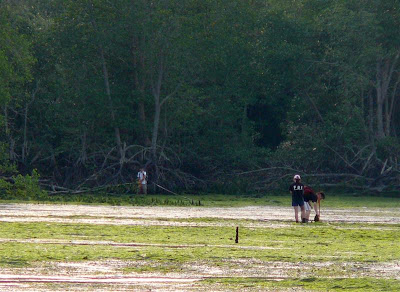
This is one of the two teams with Yilin, Demin (with the quadrat) and the experienced Siyang. While we reached the start point, the tide was still yet to be completely receded so there was a bit of wading to do.

And this is the same group in action. Transect 2 is the toughest in terms of terrain yet they broke my record and completed it very fast, of course without compromising on accuracy. Well done!

And here we have the other team in action, with Yujie, Sheong Leng, Nicholas and Jian An. They spotted a number of interesting animals along the transect and that's reassuring.
Also, Chek Jawa was kind of crowded from the boardwalk side as it was a Saturday. The Nparks guided walk was ongoing too while we see Adelle and Choon Beng on the ground too :)

And here we have Jian An and Sheong Leng with a pretty sunset backdrop while they were keeping the transect lines. Jian An's sole fell off and he had to wear Sheong Leng's booties to work the last transect, while the barefooted Sheong Leng helped us looked after our belongings at the sandbar. Working with barefoot is obviously a no no as there are many nasty sharp things hidden on the lagoon.

Nicholas and Yujie! This is Nicholas' first time (Jian An's also) down to an intertidal shore and they said they really found the place to be interesting. That's nice. This is also Yujie's second time helping me out with the transect. Thanks.

While we were moving from transects to transects, we encountered many interesting animals, including this seahorse at the seagrass lagoon.

This is a tiger moon snail. Other animals found along the way where I have no time to take photo will be lots of grown-bigger sandfish sea cucumbers, brittlestars, sandstars, hairy seahares etc.
We completed our 3 transects within target, that is before it turns totally dark. This is because yesterday's last transect photos turned out blur. It was also difficult to do video-ing of the whole stretch in total darkness with lights from the torches combined together. Therefore, work has to be done real fast while we redo one of yesterday's transect in addition. So horray! Mission accomplished. Thanks to all of the hard work of the volunteers.

We had a bit more time to spare so the guys could explore the wonderful shores a bit. Heard interesting things from them after which, including an exciting find of the warty sea cucumber which I have yet to see before in CJ. Yujie found this real small catfish. Look at the size as compared to the cockle shell. This is really cute.

Hidden beside the rock is this Salmacis sea urchin.

There is also this venus shell with the siphon sticking out a bit. Ironically, I saw many of these guys at Changi Village where they sold seafood.

Today's team was efficient and quick. The cleaning up was done in a moment, as compared to previous times of trying to untangle tapes in hours. Perhaps they heeded my warning to never entangle the tapes which will be a disaster. Haha.

As the cleaning was going on, I went to the storeroom and get our things out and realized ants invaded my big bag. Ended up washing the whole bag and getting rid of the ants, together with many bites. Soon, we hopped up to Uncle Chu's van and back we go with the bumboat. Finished everything at 9pm.

A group photo before we left for separate ways and also for well deserved dinner at Changi Village. A BIG thank you to all who came and help. Really appreciate everyone's effort, contributing to Chek Jawa in one way or another.

The story repeats where I had to sort out the enormous tons of tapes to clean and dry at home. :P
Anyway other than thanking everyone for the effort and precious time taken to help out, also want to thank God for ensuring everything run smooth when manpower was lesser. The weather for the second day was much better than the first and we could lay the line with much ease. There were no rain, so that's very optimal. Haha.
Looking forward for the next trip where we are going to monitor different groups of animals. That will be October 27. Anyone interested to join for the working trip, please email me at koksheng at nus.edu.sg. Pls take away any spacing from the email add and replace at with @, this is to prevent spamming. Thanks and take care to all. See you soon.















.JPG)
.JPG)
.JPG)

.JPG)